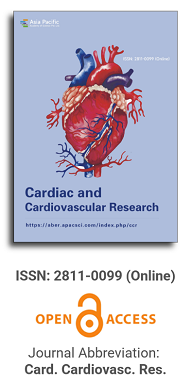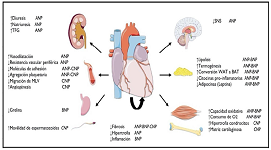
Asia Pacific Academy of Science Pte. Ltd. (APACSCI) specializes in international journal publishing. APACSCI adopts the open access publishing model and provides an important communication bridge for academic groups whose interest fields include engineering, technology, medicine, computer, mathematics, agriculture and forestry, and environment.

Abnormal spirometry is a predictor of exercise capacity in patients with tetralogy of Fallot
Vol 5, Issue 2, 2024
Download PDF
Abstract
We investigated the association between cardiac factors, spirometry, and exercise testing in patients with tetralogy of Fallot (TOF). Clinical data from patients with TOF performing a cardiopulmonary exercise test (CPET) was collected retrospectively over a 10-year period. 122 patients with TOF were identified, 52 excluded for incomplete exercise, spirometry, or cardiac data for 70 total patients included in the study. There was a male predominance 39 (56%), a mean age of 25 ± 12 years, with 28 (40%) < 18 years of age. The mean number of cardiac surgeries was 2.1 ± 1.2. Most, 46 (69%) had moderate to severe pulmonary valve insufficiency (PI) and 34 (51%) had moderate to severe right ventricular (RV) dilation. Mean forced vital capacity (FVC) was low at 81.8% predicted, and 32 (46%) with low FVC (< 80% predicted). Overall peak VO2/kg was low with a mean of 58.2 ± 13.2 % predicted. Using multiple regression analysis, a higher number of cardiac surgeries was an independent predictor of lower FVC (p = 0.01). Lower FVC was itself an independent predictor of lower peak VO2/kg and O2 pulse (p < 0.05). Moderate or severe RV systolic dysfunction was an independent predictor of stroke volume response (p = 0.03). Higher body mass index (BMI) was an independent predictor of all exercise measures being worse (p < 0.05). Low FVC and reduced exercise capacity were common in our population of TOF patients. Low FVC was predictive of low exercise capacity while, of the cardiac measures only RV systolic dysfunction was significant and predictive of stroke volume response. Spirometry may be a valuable screening tool in evaluation of TOF patients.
Keywords
References
- Cerrone D, Lewinter K, Masood I, et al. Prevalence of Abnormal Spirometry in Patients with Congenital Heart Disease. C67. Lung Function Test. 2019. doi: 10.1164/ajrccm-conference.2019.199.1_MeetingAbstracts.A5459
- Opotowsky AR, Landzberg MJ, Earing MG, et al. Abnormal spirometry after the Fontan procedure is common and associated with impaired aerobic capacity. American Journal of Physiology-Heart and Circulatory Physiology. 2014; 307(1): H110-H117. doi: 10.1152/ajpheart.00184.2014
- Akam-Venkata J, Sriram C, French M, et al. Does Restrictive Lung Function Affect the Exercise Capacity in Patients with Repaired Tetralogy of Fallot? Pediatric Cardiology. 2019; 40(8): 1688-1695. doi: 10.1007/s00246-019-02205-0
- Rabinovitch M, Herrera-deLeon V, Castaneda AR, et al. Growth and development of the pulmonary vascular bed in patients with tetralogy of Fallot with or without pulmonary atresia. Circulation. 1981; 64(6): 1234-1249. doi: 10.1161/01.cir.64.6.1234
- Mahle WT, McBride MG, Paridon SM. Exercise Performance in Tetralogy of Fallot: The Impact of Primary Complete Repair in Infancy. Pediatric Cardiology. 2002; 23(2): 224-229. doi: 10.1007/s00246-001-0054-7
- Marcuccio E, Arora G, Quivers E, et al. Noninvasive Measurement of Cardiac Output During Exercise in Children with Tetralogy of Fallot. Pediatric Cardiology. 2012; 33(7): 1165-1170. doi: 10.1007/s00246-012-0276-x
- Kipps AK, Graham DA, Harrild DM, et al. Longitudinal Exercise Capacity of Patients with Repaired Tetralogy of Fallot. The American Journal of Cardiology. 2011; 108(1): 99-105. doi: 10.1016/j.amjcard.2011.02.349
- Leonardi B, Gentili F, Perrone MA, et al. Cardiopulmonary Exercise Testing in Repaired Tetralogy of Fallot: Multiparametric Overview and Correlation with Cardiac Magnetic Resonance and Physical Activity Level. Journal of Cardiovascular Development and Disease. 2022; 9(1): 26. doi: 10.3390/jcdd9010026
- Meadows J, Powell AJ, Geva T, et al. Cardiac Magnetic Resonance Imaging Correlates of Exercise Capacity in Patients with Surgically Repaired Tetralogy of Fallot. The American Journal of Cardiology. 2007; 100(9): 1446-1450. doi: 10.1016/j.amjcard.2007.06.038
- Dallaire F, Wald RM, Marelli A. The Role of Cardiopulmonary Exercise Testing for Decision Making in Patients with Repaired Tetralogy of Fallot. Pediatric Cardiology. 2017; 38(6): 1097-1105. doi: 10.1007/s00246-017-1656-z
- Giardini A, Specchia S, Coutsoumbas G, et al. Impact of pulmonary regurgitation and right ventricular dysfunction on oxygen uptake recovery kinetics in repaired tetralogy of Fallot. European Journal of Heart Failure. 2006; 8(7): 736-743. doi: 10.1016/j.ejheart.2006.01.012
- Müller J, Hager A, Diller GP, et al. Peak oxygen uptake, ventilatory efficiency and QRS-duration predict event free survival in patients late after surgical repair of tetralogy of Fallot. International Journal of Cardiology. 2015; 196: 158-164. doi: 10.1016/j.ijcard.2015.05.174
- Giardini A, Specchia S, Tacy TA, et al. Usefulness of Cardiopulmonary Exercise to Predict Long-Term Prognosis in Adults with Repaired Tetralogy of Fallot. The American Journal of Cardiology. 2007; 99(10): 1462-1467. doi: 10.1016/j.amjcard.2006.12.076
- Wasserman K, Hansen JE, Sue DY, et al. Principles of Exercise Testing and Interpretation: Including Pathophysiology and Clinical Applications. Available online: https://api.semanticscholar.org/CorpusID:80134259 (accessed on 14 May 2024).
- Bongers B, Hulzebos H, Blank A, et al. The oxygen uptake efficiency slope in children with congenital heart disease: construct and group validity. European Journal of Cardiovascular Prevention & Rehabilitation. 2011; 18(3): 384-392. doi: 10.1177/1741826710389390
- Sun XG, Hansen JE, Stringer WW. Oxygen uptake efficiency plateau: physiology and reference values. European Journal of Applied Physiology. 2011; 112(3): 919-928. doi: 10.1007/s00421-011-2030-0
- O’Byrne ML, McBride MG, Paridon S, et al. Association of Habitual Activity and Body Mass Index in Survivors of Congenital Heart Surgery: A Study of Children and Adolescents with Tetralogy of Fallot, Transposition of the Great Arteries, and Fontan Palliation. World Journal for Pediatric and Congenital Heart Surgery. 2018; 9(2): 177-184. doi: 10.1177/2150135117752122
- Masood IR, Detterich J, Cerrone D, et al. Reduced Forced Vital Capacity and the Number of Chest Wall Surgeries are Associated with Decreased Exercise Capacity in Children with Congenital Heart Disease. Pediatric Cardiology. 2021; 43(1): 54-61. doi: 10.1007/s00246-021-02692-0
- Quattrone A, Lie OH, Nestaas E, et al. Long-term follow-up and sex differences in adults operated for tetralogy of Fallot. Open Heart. 2021; 8(2): e001738. doi: 10.1136/openhrt-2021-001738
Supporting Agencies
None
Copyright (c) 2024 Natalie Pexton, Rajeev Bhatia, Hamy Temkit, Arash Sabati
License URL: https://creativecommons.org/licenses/by/4.0/

This site is licensed under a Creative Commons Attribution 4.0 International License (CC BY 4.0).

Prof. Prakash Deedwania
University of California,
San Francisco, United States




